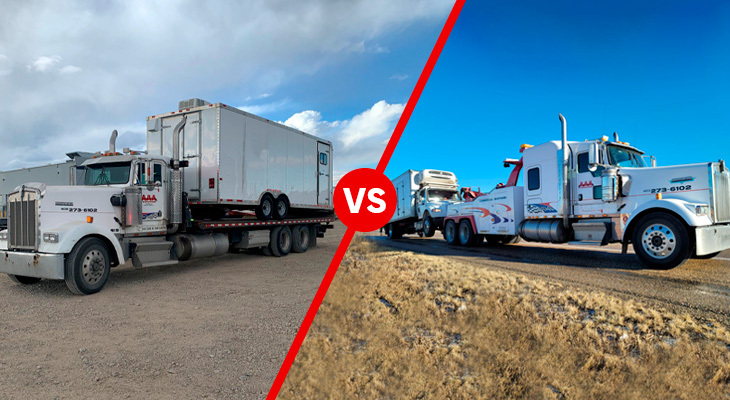
When a heavy vehicle breaks down or needs relocation, the towing method you choose can make or break your entire recovery process.
From commercial trucks to construction equipment, heavy towing requires precision, specialized equipment, and the right approach. But which method is better, using a traditional tow truck or calling in a flatbed?
The answer isn’t as straightforward as it may seem. While both serve the same core purpose, moving a vehicle from one location to another, their design, safety mechanisms, and vehicle compatibility differ significantly, especially when it comes to heavy-duty towing.
For fleet managers, property developers, or even everyday drivers with large SUVs or RVs, understanding these differences is essential.
Choosing the wrong method can result in additional wear, unexpected repair bills, or even regulatory issues. On the flip side, calling the right tow truck company can save time, money, and stress.
This blog breaks down the key differences between traditional tow trucks and flatbeds and explains when one option may outperform the other, particularly for heavy-duty situations. If you’re dealing with oversized vehicles, commercial equipment, or high-value rigs, keep reading. This is the comparison you need.
What Are Traditional Tow Trucks?
Traditional tow trucks (often called wreckers or wheel-lift trucks) use a hydraulic boom or cradle to lift a portion of the vehicle off the ground. The vehicle is towed with two wheels on the road, while the other two are suspended.
Benefits
- Quick Deployment: These trucks can be dispatched and attached faster than flatbeds, ideal for clearing blocked roadways.
- Excellent Manoeuvrability: Traditional tow trucks handle tight spaces and congested areas better than their bulkier flatbed counterparts.
- Budget-Friendly: In many cases, this method is less expensive than flatbed towing due to reduced equipment and labour time.
Limitations
- Not Suitable For All Vehicles: All-wheel-drive, low-clearance, or high-value vehicles may suffer drivetrain damage if towed this way.
- More Risk of Road Damage: The part of the vehicle touching the ground is exposed to debris, potholes, and friction.
For short distances or in emergencies, a reliable tow truck company may recommend a wheel-lift tow. But in the context of heavy towing, there are often safer and more stable alternatives.
What Is Flatbed Towing?
Flatbed tow trucks feature a long, hydraulically operated platform that inclines to ground level. The vehicle is then driven or winched onto the platform and secured for transport.
Benefits For Heavy-Duty Loads
- Complete Load Isolation: The entire vehicle is lifted off the ground, eliminating any contact with the road.
- Damage Prevention: Especially useful for luxury buses, heavy equipment, or vehicles with transmission or wheel damage.
- Better Weight Distribution: Heavy loads are more balanced on a flat surface, reducing the risk of tipping or stress on vehicle components.
- Ideal For Long-Distance Hauling: The vehicle remains stationary throughout the journey, minimizing wear and vibration.
Drawbacks
- Larger Footprint: Flatbed trucks require more room to load/unload, making them less practical in tight urban spaces.
- Slightly Higher Cost: Due to equipment complexity and loading time, flatbed services can be more expensive.
If you’re working with a tow truck company that offers both services, flatbeds are generally the preferred option for oversized, delicate, or all-wheel-drive vehicles.
Flatbed Vs. Tow Truck: Heavy Towing Comparison Chart
| Feature | Traditional Tow Truck | Flatbed Tow Truck |
| Vehicle Type | Light to medium-duty | Medium to heavy-duty |
| Road Contact | Two wheels on the road | No road contact |
| Safety For Load | Moderate | High |
| Cost | More economical | Slightly more expensive |
| Ease of Use | Quick hook-up | Requires time and winching |
| Ideal For | Emergency short tows | Long hauls, valuable or heavy loads |
| Risk of Damage | Higher risk | Minimal risk |
When To Choose Traditional Tow Trucks For Heavy Jobs
There are rare cases where a traditional tow truck might be used for a heavy-duty tow:
- When Time is Critical: On busy highways, where a large vehicle blocks lanes.
- For Upright Semi Cab Tows: If only the cab of a big rig is being moved short distances.
- In Confined Areas: When a flatbed cannot physically enter.
Even then, ensure your tow truck company has the proper licensing, equipment, and insurance to handle heavy-duty recovery safely.
When Flatbeds Are the Clear Winner
In most heavy-duty situations, flatbed towing is the smarter, safer, and more professional option. You should always request a flatbed if:
- You’re transporting construction or industrial equipment
- Your truck or rig is stuck in mud, snow, or off-road areas
- The vehicle is inoperable or has significant wheel/frame damage
- You’re covering long distances or highway transport routes
- You own a commercial vehicle with specialized attachments
A reputable tow truck company will typically evaluate the vehicle, terrain, and distance before dispatching the most appropriate towing method.
About Us
At AAA Towing, we specialize in heavy-duty towing, flatbed services, underground recoveries, and equipment hauling across Calgary and surrounding areas. With over four decades of industry experience, our team handles everything from commercial truck breakdowns to delicate vehicle transports.
We operate one of the most extensive fleets in Western Canada, allowing us to dispatch the right truck for every situation.
So, are you looking for a professional tow truck company you can trust? Contact us today for reliable, fast, and damage-free service.
Fast & Reliable Towing
We make sure each customer is completely satisfied before we leave the job.